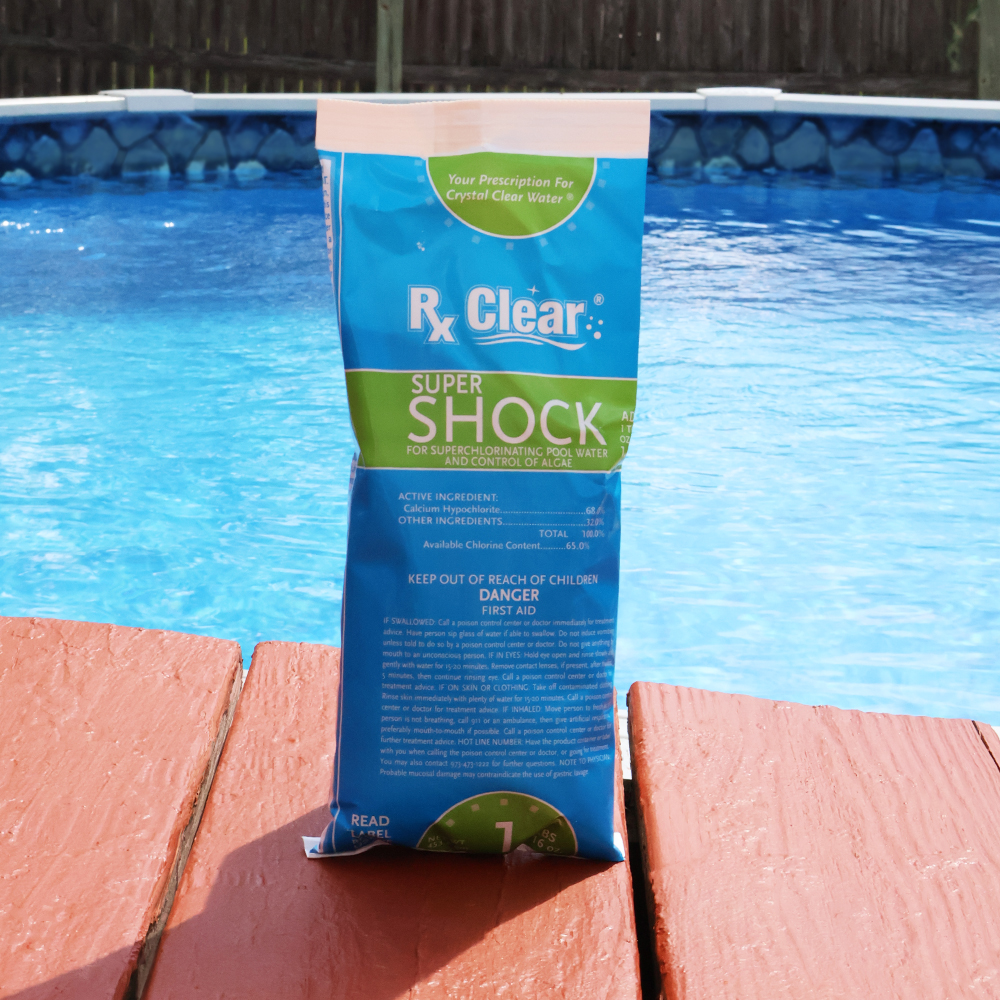The Beginner's Guide to Shocking Your Swimming Pool

Everyone who owns a pool will need to shock it, whether it’s above ground or inground, and whether their system is chlorine, bromine, saltwater, or biguanide.
Systems must be shocked at least once every two weeks or weekly if your pool sees heavy use. In addition to these routine treatments, you should also shock your pool in more specialized circumstances, such as large pool parties, significant water level changes, severe rainstorms, or any event that causes a lot of debris to fall into it.
You’ll shock your pool so often that it will eventually become routine. So, how do you shock your pool in the right way?
Safety
Shock is a chemical, usually pure, concentrated chlorine, and thus should be handled with care. If shock gets on your clothes, it will most likely bleach them; if it gets on your skin or your eyes, it will burn. Be sure to read any safety precautions on the packaging so you know what to do in an emergency, and keep clean water nearby if you need to wash it off your skin or eyes.
To ensure your safety throughout the process, wear long-sleeved shirts and pants that you don’t mind getting bleached in case of accidents, chemical-resistant gloves, and protective eyewear.
Calculate The Number Of Gallons In Your Pool
Before you buy your shock, you need to know the number of gallons in your pool. Our blog, How to Calculate Gallons in a Pool (Without Overthinking It), provides a step-by-step guide on how to do this.
Test Your Pool Water
Testing your water is essential before you change your pool’s chemistry. If your Total Chlorine level exceeds your Free Chlorine level, your combined chlorine is off it’s time to shock your pool.
Check your pH and alkalinity levels, too. For your shock treatment to be most effective, your pH should be between 7.4 and 7.6, and your alkalinity between 100 and 150 ppm.
Dilute Your Shock
It is always recommended to mix and dilute the shock with a small amount of water before adding it to your pool. Undiluted shock can cause stains or bleach damage to vinyl pool liners, so dilute your shock by filling a bucket or watering can with water and adding chlorine. Mix it up until there are no more solid granules.
One last thing, it’s best to shock your pool at night. UV rays from the sun can make chlorine less effective.
Add Shock To Your Pool
Ensure your pool pump and filter run at full speed to help mix the shock more effectively. Keep it running for 8-12 hours after you’ve shocked it, to ensure it’s properly distributed throughout your system.
Slowly pour the shock into your pool while walking around it to evenly distribute it.
Wait
Do not use your pool until you have tested your water's free chlorine levels at 5 ppm or under.
What If I Have A Saltwater Pool?
All saltwater pools are technically chlorine pools, except they make their chlorine from the salt in their saltwater generator. Some saltwater systems have a “super chlorinate” button that ramps up the chlorine production and helps shock your pool. However, it is recommended that you use non-chlorine shock for your saltwater pool.
What If I Have A Bromine Pool?
You should still use chlorine to shock your pool! While bromine can provide certain advantages over chlorine as a pool sanitizer, chlorine is still a more effective oxidizer to make it more effective at killing and preventing algae. Shocking your pool also removes bromamines - the bromine equivalent of chloramines.
What If I Have A Biguanide Pool?
If your primary sanitizer is biguanide, your pool still needs to be shocked, but not with chlorine. Instead, Biguanide systems must be shocked with a liquid containing hydrogen peroxide as the active ingredient. This type of shock typically shocks a biguanide pool once per month, barring algae appearances.

FAQs
What Does "Shocking" A Pool Mean?
Shocking a pool refers to adding a large dose of chlorine or another chemical (like a non-chlorine shock) to break down organic contaminants, kill algae, and restore water clarity.
How Often Should I Shock My Pool?
Typically, once a week, but also after heavy use, rainstorms, or algae blooms.
What Types Of Shock Are There?
-
Calcium Hydrochlorite, aka the “standard” shock, must be used after dusk and will take roughly eight hours before you can swim again.
-
Chlorine-Free Shock - If you don’t want to use chlorine in your pool, or if you have a salt water pool, chlorine-free shock can be a good alternative to Calcium Hydrochlorite.
Can You Swim Right After Shocking The Pool?
No—you should wait until the free chlorine levels in your pool drop below 5 ppm or follow the product label.
How Much Shock Do I Need To Use?
That depends on pool size, the level of contamination or algae, and the type of shock you’re using.
Follow the package instructions for a standard shock, but you might need two to three times that amount if you are trying to treat algae.






 Pools
Pools Spas
Spas Liners
Liners Equipment
Equipment Covers
Covers Accessories
Accessories Cleaning
Cleaning  Pool Fun
Pool Fun  Clearance
Clearance

